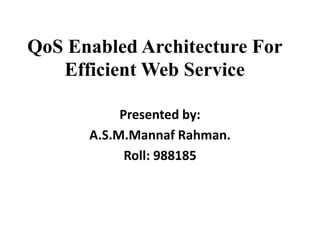
QoS Enabled Architecture for efficient web service (1)
- 1. QoS Enabled Architecture For Efficient Web Service Presented by: A.S.M.Mannaf Rahman. Roll: 988185
- 2. Executive Summary This project is concerned with quality attributes for Web Services Web Services are in great demand. They can be described, published and located over the World Wide Web. In this project, We will try to present a QoS-capable Web service architecture, QCWS, by introducing a QoS broker module between service clients and providers.
- 3. Objective Through out the presented project, We have tried to accomplish the following objectives: To Analyze QoS Evaluation of Web Service. To Minimize the Resource Wastage of Web Service. To Get the Better Idea about the Recent Development in the field of Web Base QoS.
- 4. Key Components Web Server The term web server can refer to either the hardware (the computer) or the software(the computer application) that helps to deliver web content that can be accessed through the Internet.
- 5. Key Components Web Service Web Services can convert your applications into Web-applications. It is published, found, and used through the Web. Web services are application components. Web services communicate using open protocols Web services can be discovered using UDDI
- 6. Key Components QoS • Availability – Ready for immediate consumption – Probability the system is up (related to reliability) – Time-to-Repair is associated with availability: the time it takes to repair the WS
- 7. Key Components QoS • Accuracy – The error rate generated by the WS. The number of errors that the service generates over a time interval should be minimized • Reliability – The percentage of packets discarded by a router.
- 8. Key Components QoS • Security • Latency -The delay in data transmission from source to destination. • Jitter -The variation in latency.
- 9. Related Works • A lot of research activities have been done in the area of how to realize the QoS support in Web services. • Focus on extending UDDI registry to support QoS information (Ran, S., 2009; Shaikhali, et al.,2009). • UDDIe project (Shaikhali, et al., 2011)extends the current UDDI registry by adding“bluepages”.
- 10. QCWS Three Entities of QCWS : Server QoS Broker Clients
- 12. Server • Provide Functionalities information to Broker. • Provide QoS Information about its services
- 13. Server Contents QoS Information. Qos Admission And Enforcement. Web Services.
- 14. Service oriented Server The first class not build with QoS supports, referred as Legacy Server. Here Clients are treated equally and scheduled using native schedulers in the OS. Other class of servers build with QoS support and called QoS server. They have the ability to assign different amount of system resources to different clients according to their QoS requirements.
- 15. QoS Broker A QoS broker receives clients’ functional & QoS requirement requests and identifies qualified services for them.
- 16. QoS Broker Contents QoS Information Manager. QoS Negotiation Manager. QoS Analyzer.
- 17. QoS Broker
- 18. Clients As the end users of Web services, Clients send their service request and QoS requirements to a broker and ask the broker to select a server for them. Clients also collect the QoS result information after each service call and send them to the broker.
- 19. Function of QCWS The QoS broker module collects the QoS information about service providers (servers). Makes service selection decisions for clients. and Negotiates with some of the servers to meet the QoS requirements.
- 20. Resource Allocation(HQ) Set the allocation policy: (K: current number of clients) • · If K ≤ A1, the resources allocated to each client = R/ A1; • · If Ai ≤ K ≤ Ai+1(1 ≤ i < m), the resources allocated to each client = R/Ai+1; • · If K ≥ Am, allocated resource =R/K.
- 21. Homogeneous Resource Allocation Algorithm HQ There are several terms we define in this project: · Total System Utility (Ug(t)): Summation of all active (currently receiving services) clients’ utility at time t; · Average System Utility (Uavg): The integral of the instantaneous total system utility with respect to time divided by the time period through which it is measured; · Reconfiguration: Reconfiguration means resources are reallocated among existing clients and the incoming client; · Reconfiguration Rate: The total number of reconfigurations divided by the time through which it is measured
- 22. Algorithm HQ The system performance is measured by Uavg and the QoS instability is measured by the reconfiguration rate. The goal of the resource allocation algorithm is to optimize the system performance while reducing the QoS instability.
- 23. Non-homogeneous Resource Allocation RQ The algorithm RQ has the following parameters: · W: weight of the virtual client; · Nr: number of clients to be reconfigured during a reconfiguration; · Uc(r): client’s utility function; · Uvc(r): virtual client’s utility function;
- 24. Example for Resource allocation
- 25. Allocation RQ The rules for selecting Nr clients for reconfiguration are: • a. Choose clients that are receiving resources more than their minimum resource requirements; • b. Choose clients that have the biggest differences between their minimum resource requirements and currently assigned resources; • c. If the result of reconfiguration will cause a client to drop below the minimum service level it should receive, remove it from Nr list. • b. Repeat this step until an available allocation is found.
- 26. Conclusion • All of the approaches proposed in this project are aiming at improving QoS management of Web services. • We discussed about QoS evaluation. • The remaining part introduces resource allocation algorithm for better QoS capable web services.
- 27. Thank You